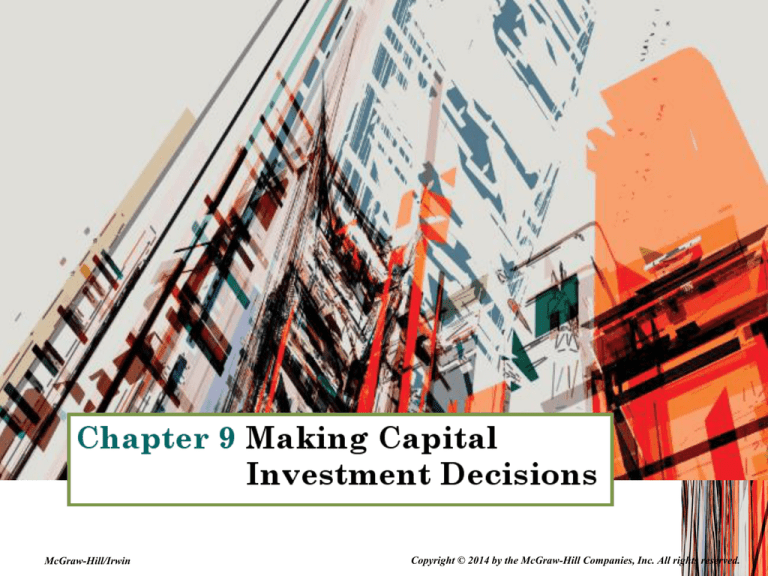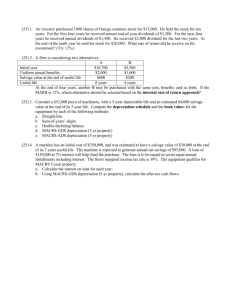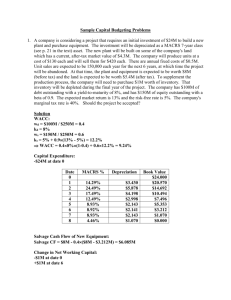
McGraw-Hill/Irwin
Copyright © 2014 by the McGraw-Hill Companies, Inc. All rights reserved.
Key Concepts and Skills
• Understand how to:
– Determine the relevant cash flows
for a proposed investment
– Analyze a project’s projected cash
flows
– Evaluate an estimated NPV
9-2
Relevant Cash Flows
• Include only cash flows that will only
occur if the project is accepted
• Incremental cash flows
• The stand-alone principle allows us to
analyze each project in isolation from
the firm simply by focusing on
incremental cash flows
9-3
Relevant Cash Flows:
Incremental Cash Flow for a Project
Corporate cash flow with the project
Minus
Corporate cash flow without the project
9-4
Relevant Cash Flows
•
•
•
•
•
•
“Sunk” Costs ………………………… N
Opportunity Costs …………………... Y
Side Effects/Erosion……..…………… Y
Net Working Capital………………….. Y
Financing Costs….………..…………. N
Tax Effects ………………………..….. Y
9-5
Pro Forma Statements and Cash
Flow Review
• Pro Forma Financial Statements
– Projects future operations
• Operating Cash Flow:
OCF = EBIT + Depr – Taxes
OCF = NI + Depr if no interest expense
• Cash Flow From Assets:
CFFA = OCF – NCS –ΔNWC
NCS = Net capital spending
9-6
Shark Attractant Project
•
•
•
•
•
•
Estimated sales
Sales Price per can
Cost per can
Estimated life
Fixed costs
Initial equipment cost
50,000 cans
$4.00
$2.50
3 years
$12,000/year
$90,000
– 100% depreciated over 3 year life
• Investment in NWC
• Tax rate
• Cost of capital
$20,000
34%
20%
9-7
Pro Forma Income Statement
Table 9.1
Sales (50,000 units at $4.00/unit)
Variable Costs ($2.50/unit)
$200,00
0
125,000
Gross profit
$ 75,000
Fixed costs
12,000
Depreciation ($90,000 / 3)
30,000
EBIT
Taxes (34%)
Net Income
$ 33,000
11,220
$ 21,780
9-8
Projected Capital Requirements
Table 9.2
Year
0
NWC
1
2
3
$20,000
$20,000
$20,000
$20,000
90,000
60,000
30,000
0
Total
$110,000
Investment
$80,000
$50,000
$20,000
Net Fixed
Assets
NFA declines by the amount of depreciation each year
Investment = book or accounting value, not market value
9-9
Projected Total Cash Flows
Table 9.5
Year
0
OCF
1
$51,780
NWC
-$20,000
Capital
Spending
-$90,000
CFFA
-$110,00
2
$51,780
3
$51,780
20,000
$51,780
$51,780
$71,780
Note: Investment in NWC is recovered in final year
Equipment cost is a cash outflow in year 0
9-10
Shark Attractant Project
Year
Sales
Variable Costs
Gross Profit
Fixed Costs
Depreciation
EBIT
Taxes
Net Income
Pro Forma Income Statement
0
1
200,000
125,000
75,000
12,000
30,000
33,000
11,220
21,780
Operating Cash Flow
Changes in NWC
Net Capital Spending
Cash Flow From Assets
Cash Flows
51,780
-20,000
-90,000
-110,000
51,780
Net Present Value
IRR
$10,647.69
25.76%
2
200,000
125,000
75,000
12,000
30,000
33,000
11,220
21,780
3
200,000
125,000
75,000
12,000
30,000
33,000
11,220
21,780
51,780
51,780
20,000
51,780
71,780
OCF = EBIT + Depreciation – Taxes
OCF = Net Income + Depreciation (if no interest)
9-11
Computing NPV for the Project
Using the TI BAII+ CF Worksheet
Cash Flows:
CF0
= -110000
CF1
=
51780
CF2
=
51780
CF3
=
71780
Display
You Enter
C00
C01
F01
C02
F02
I
NPV
CF, 2nd, CLR WORK
110000 Enter, Down
51780 Enter, Down
2
Enter, Down
71780 Enter, Down
1
Enter, NPV
20
Enter, Down
CPT
10647.69
IRR
CPT
25.76
9-12
Making The Decision
Operating Cash Flow
Changes in NWC
Net Capital Spending
Cash Flow From Assets
Cash Flows
51,780
-20,000
-90,000
-110,000
51,780
Net Present Value
IRR
$10,647.69
25.76%
51,780
51,780
20,000
51,780
71,780
• Should we accept or reject the project?
9-13
The Tax Shield Approach to OCF
• OCF = (Sales – costs)(1 – T) + Deprec*TC
OCF=(200,000-137,000) x 66% + (30,000 x .34)
OCF = 51,780
• Particularly useful when the major incremental
cash flows are the purchase of equipment and
the associated depreciation tax shield
– i.e., choosing between two different machines
9-14
Changes in NWC
• GAAP requirements:
– Sales recorded when made, not when cash is
received
• Cash in = Sales - ΔAR
– Cost of goods sold recorded when the
corresponding sales are made, whether suppliers
paid yet or not
• Cash out = COGS - ΔAP
• In the real world:
– Buy inventory/materials to support sales before
any cash collected
9-15
Depreciation & Capital
Budgeting
• Use the schedule required by the
IRS for tax purposes
• Depreciation = non-cash expense
– Only relevant due to tax affects
• Depreciation tax shield = DT
– D = depreciation expense
– T = marginal tax rate
9-16
Computing Depreciation
• Straight-line depreciation
D = (Initial cost – salvage) / number of years
Straight Line Salvage Value
• MACRS
Depreciate 0
Recovery Period = Class Life
1/2 Year Convention
Multiply percentage in table by the initial cost
9-17
After-Tax Salvage
• If the salvage value is different from
the book value of the asset, then
there is a tax effect
• Book value = initial cost –
accumulated depreciation
• After-tax salvage = salvage –
T(salvage – book value)
9-18
Tax Effect on Salvage
Net Salvage Cash Flow
= SP - (SP-BV)(T)
Where:
SP = Selling Price
BV = Book Value
T = Corporate tax rate
9-19
Example:
Depreciation and After-tax Salvage
• Car purchased for $12,000
• 5-year property
• Marginal tax rate = 34%.
Depreciation
Year
1
2
3
4
5
6
$
$
$
$
$
$
5-year Asset
Beg BV
12,000.00
9,600.00
5,760.00
3,456.00
2,073.60
691.20
Depr %
20.00%
32.00%
19.20%
11.52%
11.52%
5.76%
100.00%
$
$
$
$
$
$
$
Deprec
2,400.00
3,840.00
2,304.00
1,382.40
1,382.40
691.20
12,000.00
$
$
$
$
$
$
End BV
9,600.00
5,760.00
3,456.00
2,073.60
691.20
-
9-20
Salvage Value & Tax Effects
Depreciation
Year
1
2
3
4
5
6
$
$
$
$
$
$
5-year Asset
Beg BV
12,000.00
9,600.00
5,760.00
3,456.00
2,073.60
691.20
Depr %
20.00%
32.00%
19.20%
11.52%
11.52%
5.76%
100.00%
$
$
$
$
$
$
$
Deprec
2,400.00
3,840.00
2,304.00
1,382.40
1,382.40
691.20
12,000.00
$
$
$
$
$
$
End BV
9,600.00
5,760.00
3,456.00
2,073.60
691.20
-
Net Salvage Cash Flow = SP - (SP-BV)(T)
If sold at EOY 5 for $3,000:
NSCF = 3,000 - (3000 - 691.20)(.34) = $2,215.01
= $3,000 – 784.99 = $2,215.01
If sold at EOY 2 for $4,000:
NSCF = 4,000 - (4000 - 5,760)(.34) = $4,598.40
= $4,000 – (-598.40) = $4,598.40
9-21
Majestic Mulch & Compost Co
Majestic Mulch and Compost Company (MMCC)
YEAR
0
Background Data:
Unit Sales Estimates
Variable Cost /unit
Fixed Costs per year
Sale Price per unit
Tax Rate
Required Return on Project
Yr 0 NWC
NWC % of sales
Equipment cost - installed
Salvage Value in year 8
$
$
$
$
$
Depreciation Calculations:
Equipment Depreciable Base
MACRS % (Eqpt-7 yr)
Recovery Allowance
Book Value
After-Tax Salvage Value
Salvage Value
Book Value (Year 8)
Capital Gain/Loss
Taxes
Net SV (SV-Taxes)
1
3,000
60.00
25,000.00
120.00
$ 120.00 $
34.0%
15.0%
20,000.00
15%
800,000
20% of equipment cost
2
5,000
120.00 $
3
6,000
120.00 $
4
6,500
110.00 $
5
6,000
110.00 $
6
5,000
110.00 $
7
8
4,000
3,000
110.00 $
110.00
800,000
20%
14.29%
114,320
685,680
24.49%
195,920
489,760
17.49%
139,920
349,840
12.49%
99,920
249,920
8.92%
71,360
178,560
8.93%
71,440
107,120
8.93%
71,440
35,680
4.46%
35,680
0
54,000
90,000
108,000
107,250
99,000
82,500
66,000
49,500
160,000
0
160,000
54,400
105,600
Required Net Working Capital Investment
20,000
Given Data and Projected Revenues – Table 9.9
9-22
Majestic Mulch & Compost Co
Majestic Mulch and Compost Company (MMCC)
YEAR
0
Background Data:
Unit Sales Estimates
Variable Cost /unit
Fixed Costs per year
Sale Price per unit
Tax Rate
Required Return on Project
Yr 0 NWC
NWC % of sales
Equipment cost - installed
Salvage Value in year 8
$
$
$
$
$
Depreciation Calculations:
Equipment Depreciable Base
MACRS % (Eqpt-7 yr)
Recovery Allowance
Book Value
After-Tax Salvage Value
Salvage Value
Book Value (Year 8)
Capital Gain/Loss
Taxes
Net SV (SV-Taxes)
1
3,000
60.00
25,000.00
120.00
$ 120.00 $
34.0%
15.0%
20,000.00
15%
800,000
20% of equipment cost
2
5,000
120.00 $
3
6,000
120.00 $
4
6,500
110.00 $
5
6,000
110.00 $
6
5,000
110.00 $
7
8
4,000
3,000
110.00 $
110.00
800,000
20%
14.29%
114,320
685,680
24.49%
195,920
489,760
17.49%
139,920
349,840
12.49%
99,920
249,920
8.92%
71,360
178,560
8.93%
71,440
107,120
8.93%
71,440
35,680
4.46%
35,680
0
54,000
90,000
108,000
107,250
99,000
82,500
66,000
49,500
160,000
0
160,000
54,400
105,600
Required Net Working Capital Investment
20,000
Depreciation and After-Tax Salvage - Table 9.10
9-23
Majestic Mulch & Compost Co
Majestic Mulch and Compost Company (MMCC)
YEAR
Background Data:
Unit Sales Estimates
Variable Cost /unit
Fixed Costs per year
Sale Price per unit
Tax Rate
Required Return on Project
Yr 0 NWC
NWC % of sales
Equipment cost - installed
Salvage Value in year 8
0
$
$
$
$
$
Depreciation Calculations:
Equipment Depreciable Base
MACRS % (Eqpt-7 yr)
Recovery Allowance
Book Value
After-Tax Salvage Value
Salvage Value
Book Value (Year 8)
Capital Gain/Loss
Taxes
Net SV (SV-Taxes)
1
3,000
60.00
25,000.00
120.00
$ 120.00 $
34.0%
15.0%
20,000.00
15%
800,000
20% of equipment cost
2
5,000
120.00 $
3
6,000
120.00 $
4
6,500
110.00 $
5
6,000
110.00 $
6
5,000
110.00 $
7
4,000
8
3,000
110.00 $
110.00
800,000
20%
14.29%
114,320
685,680
24.49%
195,920
489,760
17.49%
139,920
349,840
12.49%
99,920
249,920
8.92%
71,360
178,560
8.93%
71,440
107,120
8.93%
71,440
35,680
4.46%
35,680
0
54,000
90,000
108,000
107,250
99,000
82,500
66,000
49,500
160,000
0
160,000
54,400
105,600
Required Net Working Capital Investment
20,000
Net Working Capital – Table 9.12
9-24
Majestic Mulch & Compost Co
YEAR
Initial Investment
Equipment Cost
Sales
Variable Costs
Fixed Costs
Depreciation (Eqpt))
0
1
2
3
4
5
6
7
8
(800,000)
EBT
Taxes
Net Operating Income
360,000
180,000
25,000
114,320
40,680
13,831
26,849
600,000
300,000
25,000
195,920
79,080
26,887
52,193
720,000
360,000
25,000
139,920
195,080
66,327
128,753
715,000
390,000
25,000
99,920
200,080
68,027
132,053
660,000
360,000
25,000
71,360
203,640
69,238
134,402
550,000
300,000
25,000
71,440
153,560
52,210
101,350
440,000
240,000
25,000
71,440
103,560
35,210
68,350
330,000
180,000
25,000
35,680
89,320
30,369
58,951
195,920
248,113
(36,000)
139,920
268,673
(18,000)
99,920
231,973
750
71,360
205,762
8,250
71,440
172,790
16,500
71,440
139,790
16,500
Add back Depreciation
CASH FLOW from Operations
NWC investment & Recovery
Salvage Value
TOTAL PROJECTED CF
(20,000)
114,320
141,169
(34,000)
(820,000)
107,169
212,113
250,673
232,723
214,012
189,290
156,290
35,680
94,631
66,000
105,600
266,231
Discounted Cash Flows
(820,000)
93,190
160,388
164,821
133,060
106,402
81,835
58,755
87,031
Cumulative Cash flows
(820,000)
(712,831)
(500,718)
(250,046)
(17,323)
196,690
385,979
542,269
808,500
NPV
IRR
Payback
$65,483
17.24%
4.08
MMC Pro Forma Income Statements
9-25
Majestic Mulch & Compost Co
YEAR
Initial Investment
Equipment Cost
Sales
Variable Costs
Fixed Costs
Depreciation (Eqpt))
0
1
2
3
4
5
6
7
8
(800,000)
EBT
Taxes
Net Operating Income
360,000
180,000
25,000
114,320
40,680
13,831
26,849
600,000
300,000
25,000
195,920
79,080
26,887
52,193
720,000
360,000
25,000
139,920
195,080
66,327
128,753
715,000
390,000
25,000
99,920
200,080
68,027
132,053
660,000
360,000
25,000
71,360
203,640
69,238
134,402
550,000
300,000
25,000
71,440
153,560
52,210
101,350
440,000
240,000
25,000
71,440
103,560
35,210
68,350
330,000
180,000
25,000
35,680
89,320
30,369
58,951
195,920
248,113
(36,000)
139,920
268,673
(18,000)
99,920
231,973
750
71,360
205,762
8,250
71,440
172,790
16,500
71,440
139,790
16,500
Add back Depreciation
CASH FLOW from Operations
NWC investment & Recovery
Salvage Value
TOTAL PROJECTED CF
(20,000)
114,320
141,169
(34,000)
(820,000)
107,169
212,113
250,673
232,723
214,012
189,290
156,290
35,680
94,631
66,000
105,600
266,231
Discounted Cash Flows
(820,000)
93,190
160,388
164,821
133,060
106,402
81,835
58,755
87,031
Cumulative Cash flows
(820,000)
(712,831)
(500,718)
(250,046)
(17,323)
196,690
385,979
542,269
808,500
NPV
IRR
Payback
$65,483
17.24%
4.08
MMC Projected Cash Flows – Table 9.14
9-26
Evaluating NPV Estimates
• NPV estimates are only estimates
• Forecasting risk:
– Sensitivity of NPV to changes in cash flow
estimates
• The more sensitive, the greater the forecasting
risk
• Sources of value
• Be able to articulate why this project creates
value
9-27
Scenario Analysis
• Examines several possible situations:
– Worst case
– Base case or most likely case
– Best case
• Provides a range of possible outcomes
9-28
Scenario Analysis Example
Units
Price/unit
Variable cost/unit
Fixed cost/year
$
$
$
Base
6,000
80.00 $
60.00 $
50,000 $
BASE
Lower
5,500
75.00 $
58.00 $
45,000 $
BEST
Upper
6,500
85.00
62.00
55,000
WORST
Initial investment
$ 200,000
Depreciated to salvage value of 0 over 5 years
Deprec/yr
$
40,000
Project Life
5 years
Tax rate
34%
Required return
12%
Note: “Lower” ≠ Worst
“Upper” ≠ Best
9-29
Scenario Analysis Example
Units
Price/unit
Variable cost/unit
Fixed Cost
Sales
Variable Cost
Fixed Cost
Depreciation
EBIT
Taxes
Net Income
+ Deprec
$
$
$
$
BASE
6,000
80.00 $
60.00 $
50,000 $
WORST
5,500
75.00 $
62.00 $
55,000 $
480,000 $
360,000
50,000
40,000
30,000
10,200
19,800
40,000
412,500 $
341,000
55,000
40,000
(23,500)
(7,990)
(15,510)
40,000
BEST
6,500
85.00
58.00
45,000
552,500
377,000
45,000
40,000
90,500
30,770
59,730
40,000
TOTAL CF
59,800
24,490
99,730
NPV
15,566
(111,719)
159,504
IRR
15.1%
-14.4%
40.9%
9-30
Problems with Scenario Analysis
• Considers only a few possible out-comes
• Assumes perfectly correlated inputs
– All “bad” values occur together and all
“good” values occur together
• Focuses on stand-alone risk, although
subjective adjustments can be made
9-31
Sensitivity Analysis
• Shows how changes in an input variable
affect NPV or IRR
• Each variable is fixed except one
– Change one variable to see the effect on NPV
or IRR
• Answers “what if” questions
9-32
Sensitivity
Analysis:
Units
Price/unit
Variable cost/unit
Fixed cost/year
$
$
$
Base
6,000
80
60
50,000
Units
5,500
80
60
50,000
Units
6,500
80
60
50,000
Initial investment
$ 200,000
Depreciated to salvage value of 0 over 5 years
Deprec/yr
$
40,000
Unit Sales
Tax rate
Required Return
34%
12%
Units
Price/unit
Variable cost/unit
Fixed cost
BASE
6,000
80 $
60 $
50,000 $
Unit Sales Sensitivity
50,000.00
40,000.00
$39,357
$
$
$
UNITS
5,500
80 $
60 $
50,000 $
UNITS
6,500
80
60
50,000
30,000.00
NPV
20,000.00
$15,566
10,000.00
0.00
5,500
-10,000.00
6,000
$(8,226)
-20,000.00
Unit Sales
6,500
Sales
Variable Cost
Fixed Cost
Depreciation
EBIT
Taxes
Net Income
+ Deprec
$
TOTAL CF
NPV
480,000
360,000
50,000
40,000
30,000
10,200
19,800
40,000
$
59,800
$
15,566
$
440,000
330,000
50,000
40,000
20,000
6,800
13,200
40,000
$
520,000
390,000
50,000
40,000
40,000
13,600
26,400
40,000
53,200
66,400
(8,226) $
39,357
9-33
Units
Price/unit
Variable cost/unit
Fixed cost/year
Sensitivity
Analysis:
$
$
$
Base
6,000
80
60
50,000
Fixed Cost
6,000
80
60
55,000
Fixed Cost
6,000
80
60
45,000
Initial investment
$ 200,000
Depreciated to salvage value of 0 over 5 years
Deprec/yr
$
40,000
Fixed Costs
Tax rate
Required Return
34%
12%
Units
Price/unit
Variable cost/unit
Fixed cost
BASE
6,000
80 $
60 $
50,000 $
Fixed Cost Sensitivity
30,000.00
$27,461
25,000.00
$
$
$
FC
6,000
80 $
60 $
55,000 $
FC
6,000
80
60
45,000
NPV
20,000.00
$15,566
15,000.00
10,000.00
5,000.00
$3,670
0.00
$45,000
$50,000
Fixed Cost
Sales
Variable Cost
Fixed Cost
Depreciation
EBIT
Taxes
Net Income
+ Deprec
$
480,000
360,000
50,000
40,000
30,000
10,200
19,800
40,000
$
480,000
360,000
55,000
40,000
25,000
8,500
16,500
40,000
$
480,000
360,000
45,000
40,000
35,000
11,900
23,100
40,000
$55,000
TOTAL CF
NPV
59,800
$
15,566
56,500
$
3,670
63,100
$
9-34
27,461
Sensitivity Analysis:
• Strengths
– Provides indication of stand-alone risk.
– Identifies dangerous variables.
– Gives some breakeven information.
• Weaknesses
– Does not reflect diversification.
– Says nothing about the likelihood of change in a
variable.
– Ignores relationships among variables.
9-35
Disadvantages of Sensitivity and
Scenario Analysis
• Neither provides a decision rule.
– No indication whether a project’s
expected return is sufficient to
compensate for its risk.
• Ignores diversification.
– Measures only stand-alone risk, which
may not be the most relevant risk in
capital budgeting.
9-36
Managerial Options
• Contingency planning
• Option to expand
– Expansion of existing product line
– New products
– New geographic markets
• Option to abandon
– Contraction
– Temporary suspension
• Option to wait
• Strategic options
9-37
Capital Rationing
• Capital rationing occurs when a firm or
division has limited resources
– Soft rationing – the limited resources are
temporary, often self-imposed
– Hard rationing – capital will never be available
for this project
• The profitability index is a useful tool when
faced with soft rationing
9-38
Chapter 9
END
9-39





